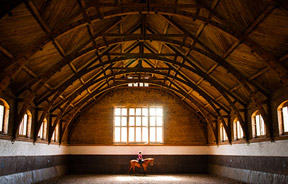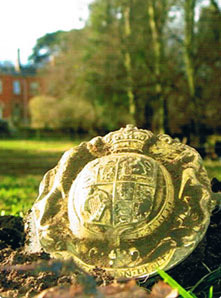
Outside of riding school (arena).
Epsom Racecourse, located in Surrey about an hour south west of London, held its first recorded race in 1661. Still today Epsom is famous for the Epsom Derby, an annual summer event that boasts a purse of over £1.25m million pounds. However, it is generally agreed that racing probably happened as far back as 1625 when one William Stanley fell off his horse and broke his neck in a horse race according to burial records. By 1684, Epsom had a clerk of the course and was holding twice yearly race meetings. However, while Epsom is a famous racecourse of note, a stable called Durdans located nearby is also a place with a rich and fascinating history.
Sir Gilbert Heathcote owned Durdan’s, and it was his horse Amato who won the first Epsom Derby in 1838. Amato was buried in the woodlands near the paddocks.
In 1874, Heathcote sold the stables to the 5th Earl of Rosebery and this young man’s passion for horses and racing took off. He was an ambitious young fellow and vowed to accomplish three main things in his life, all of which he did in spades. He married an heiress, Hanna de Rothschild, he became Prime Minister in 1894-95, and finally he wanted to own a Derby winner. As luck would have it he ended his life owning not one but three Derby winners.
An indoor riding stable was on the Earl’s ‘must have’ list in 1881, and only the best would do. Prominent architect George Devey created the stable in the Arts and Crafts style which featured many of the following:
- Wood, stone, or stucco siding
- Low-pitched roof
- Wide eaves with triangular brackets
- Exposed roof rafters
- Numerous windows
- Some windows with stained or leaded glass
- Beamed ceilings
The final result was written up as “being the finest in the country.” Presently at Durdans there are three listed buildings on the property as well as the iron entrance gates and four horse graves. In England, something that is Listed marks and celebrates a building’s special architectural and historic interest. All buildings built before 1700 which survive in anything like their original condition are listed, as are most of those built between 1700 and 1840. Monuments, gardens, battlefields, wrecks and heritage sites can also be listed. Listed builds and areas may not be demolished, extended, or altered without special permission from the local planning authority.

Inside of school showing arches.
The indoor arena or school is one of just five that still exist today and was built so that Lord Rosebery could see his mare and foals being led out and paraded before him in comfort. It is a Grade II listed building (Buckingham Palace is a Grade I Listed building by comparison). The outside of the arena might be mistaken for a church or chapel with heavy buttresses, and lovely leaded windows in stone window frames. The inside measures 15 metres by 37 metres (49.2 feet x 121.3 feet) and this includes the viewing platform. A look inside shows that the roof supports are very unique and include semi-circular arches of timber built up from three short lengths of timber and bolted together with staggered joints. The effect is stunningly beautiful, and windows allow natural light in from the sides and ends. Outside of the riding school are 12 box stalls that were also built in 1881. Today the 55 acre estate offers boarding (livery) facilities with 14 box stalls built in 2012. Cicero Stables, also a Grade II listed building has 11 stalls and a trainer’s cottage and these stables, built in 1900, were named Cicero after Lord Rosebery’s Derby winner. Today BR Johnson Racing, run by a family member, inhabits the racing stables.
Lord Rosebery was an ardent racing fan and owner. He owned two stud farms: the Durdens and another in Mentmore, Buckinghamshire. He bred 500 horses over the course of 60 years at these stables, and he was the proud owner of three Derby winners: Ladas II in 1894, Sir. Visto in 1895, and Cicero in 1905. This triple win for Rosebery translated into fame and many tributes including naming a drinking trough after Cicero which still remains today just outside the Rubbing House Restaurant on the Downs. Interestingly, the four horse graves on the property are also Grade II Listed and include Amato, Cicero, Ladas II and Sir Visto. As Lord Rosebery grew old, he could often be found sitting with his memories and his famous Derby winners in the woodlands where they lie buried in eternal rest! The graves were restored in 2014. Lady Sybil Grant, Lord Rosebery’s daughter apparently grew snowdrops near the stables in the woods. She sold these in the town of Epsom, and gave the proceeds to disabled servicemen. Still today, the snowdrops put on a beautiful display of white when they bloom in the woods in February.
The beautiful and ornate gates at the entrance of Durdans were not an original part of the estate. A Duke of Chandos had them designed and built in the early 1700s for his palace called Canons by a pupil of Tijou who created the gates for Hampton Court. When the palace was demolished in 1747 when the Duke lost his fortune, the gates were brought to Durdans. They were placed at the house initially but were moved away from that location so that the ever increasing flow of car traffic would not upset Rosebery’s horses! When Rosebery’s son went to war, the Lord locked the gates and vowed not to open them again until his son returned. Sadly his son died in 1917, and the gates, except for a brief spell in 2013 for conservation, have remained closed.

King Charles II’s bit end found at Durdens.
Like many great estates, Durdans fell into disrepair, but happily the Buckman family bought the property in 2010 and have restored it with help from the Halifax estates (the freehold owners ), and English Heritage who aided with the riding school roof restored with 16,000 Trevillet slates, each hand made from Cornwall. Volunteers from Mole Valley helped to trim back and tidy up the overgrown woodlands.
Like many estates and palaces, Durdans was hiding an interesting secret in plain view. The story goes that after the death of Oliver Cromwell, King Charles II was visited in France by a group of noblemen. The men wanted the King to return to England as monarch. Lord George Berkeley who owned Durdans at the time was one of these supporters and the Kind paid him a visit in 1662 as a thank you. As King Charles II was riding through the woods on the estate, the ornamental piece on one side of his horse’s bit must have fallen off. There it remained hidden until the 1990s when an amateur enthusiast with a metal detector found it! So important was this find that it was nominated as one of the most 100 important finds by amateur sleuths in the ITV series of 2013. The reason being that the date of its loss was noted. This items sits today in the Bourne Hall Museum in Ewell.
Thanks to Helen Buckman of Durdans for permission to use the photos.
